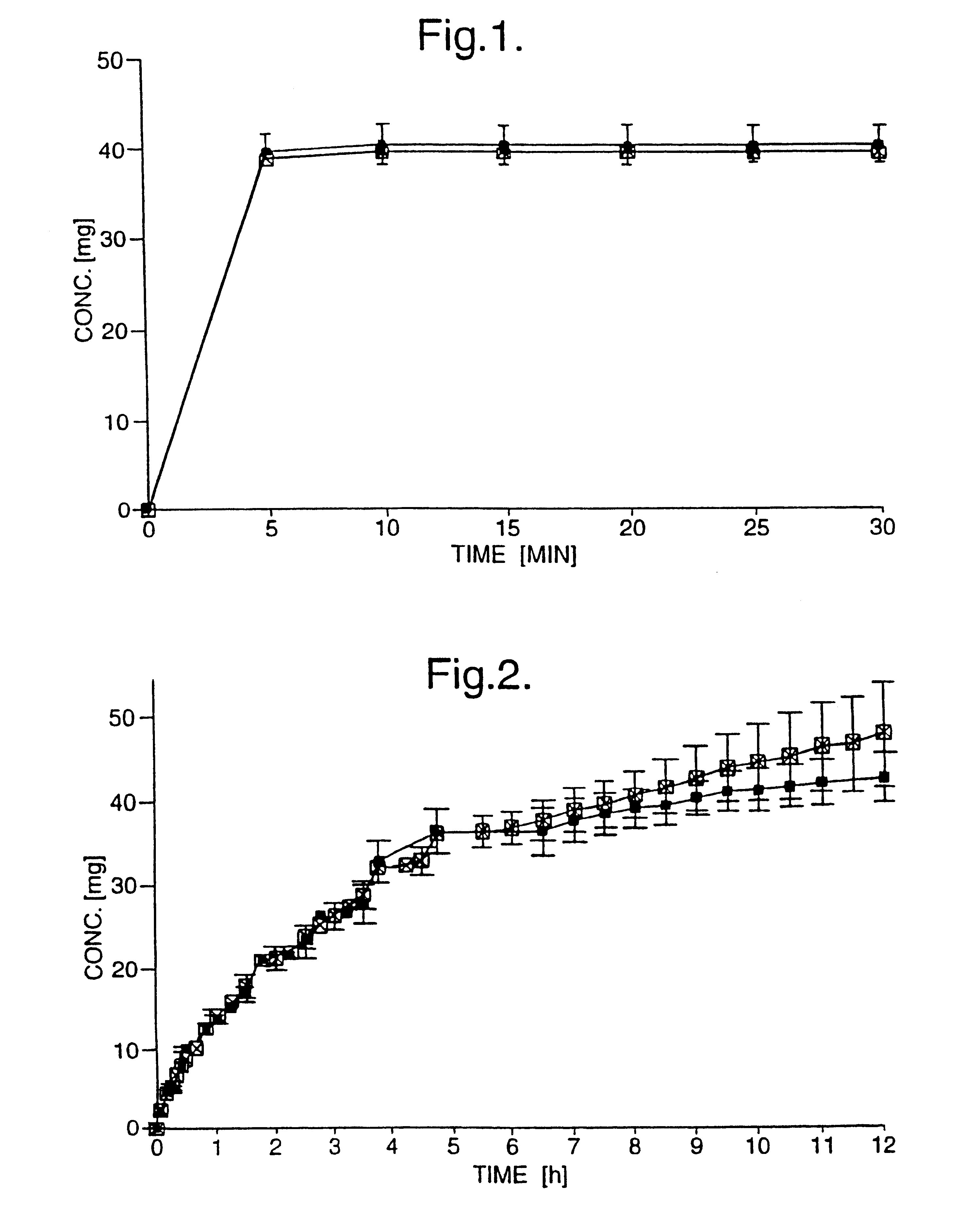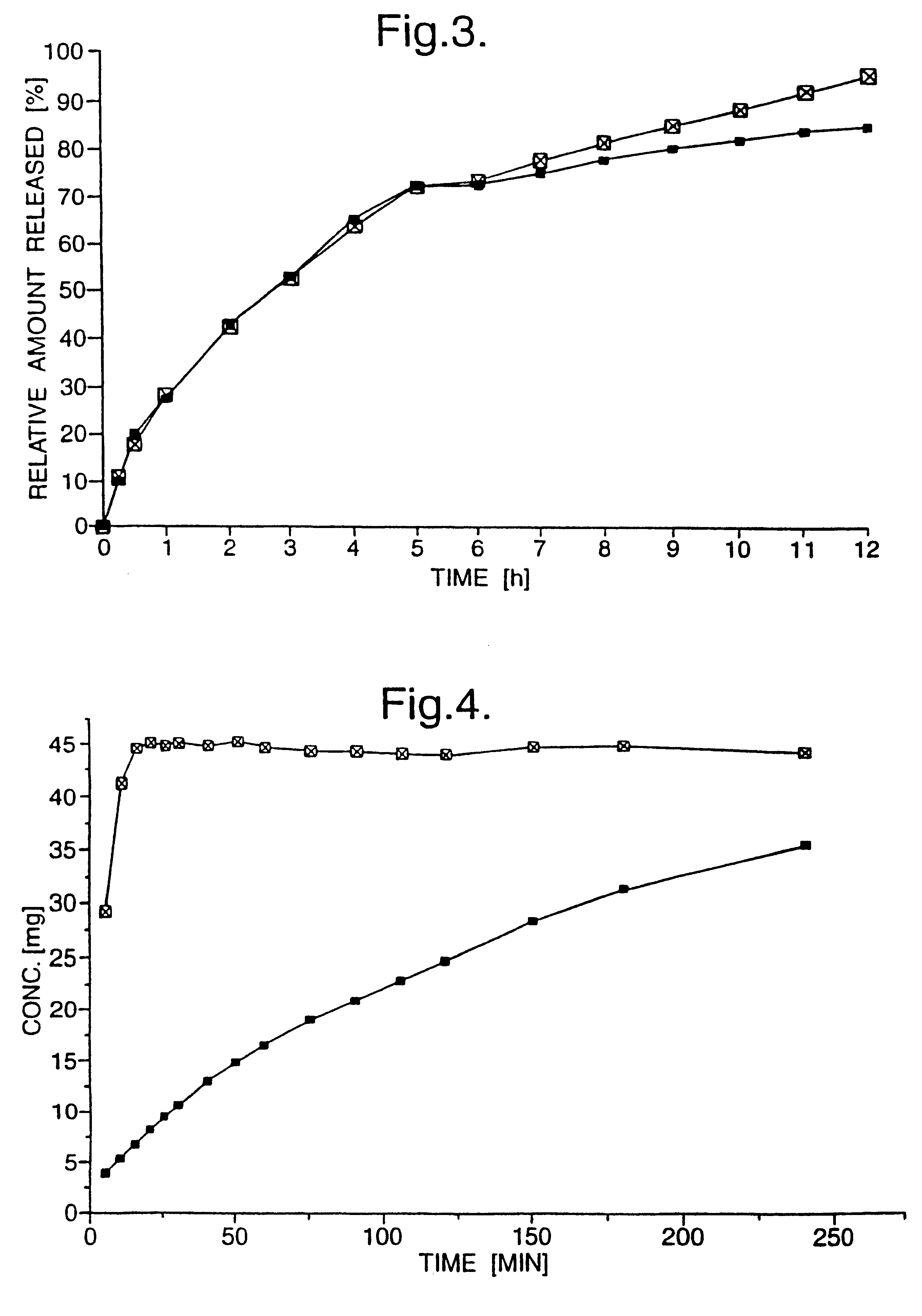Dosage forms
a technology of dosage and forms, applied in the field of dosage forms, can solve the problems of further complicated and reduced drug efficacy
- Summary
- Abstract
- Description
- Claims
- Application Information
AI Technical Summary
Benefits of technology
Problems solved by technology
Method used
Image
Examples
example 1
Immediate-release tablets were prepared from a powder mixture of 50.0 mg (+)- or (-)-tramadol hydrochloride, 46.5 mg microcrystalline cellulose, 3.0 mg croscarmellose sodium and 0.5 mg magnesium stearate, using a tabletting pressure of 200 MPa. Disintegration was monitored over 30 minutes.
The drug release from the immediate-release tablets is depicted in FIG. 1, with the y-axis showing the concentrations of the individual enantiomers in the dissolution medium. The dissolution pattern observed guarantees a rapid pharmaceutical availability of the drug.
example 2
Controlled-release tablets were prepared from a powder mixture of 50.00 mg (+)- or (-)-tramadol hydrochloride, 119.15 mg hydroxypropyl methyl cellulose (HPMC) and 0.85 mg magnesium stearate, using a tabletting pressure of 200 MPa. Disintegration was monitored over a period of 7 hours.
The drug release of the controlled-release tablets is depicted in FIG. 2, as a dissolution profile, with the y-axis showing the concentrations of the individual enantiomers in the dissolution medium, and in FIG. 3 as a percentage of drug release. A twelve hour controlled-release was achieved with the present formulation. After 6 hours, the (-)-enantiomer is releases slightly faster than the (+)-enantiomer, achieving nearly 100% drug release at 12 hours, whereas only 86% of the (+)-enantiomer was released after 12 hours. Below 6 ours, the drug release profiles of the two enantiomers were very similar.
example 3
Bi-layered tablets were prepared by pre-compressing the powder mixture of Example 2 at a tabletting pressure of 20 MPa to form a controlled-release layer. The powder mixture of Example 1, containing the opposite enantiomer of tramadol hydrochloride to that used in the controlled-release layer, was then filled on top of the controlled-release layer, and the whole tablet compressed using a tabletting pressure of 200 MPa.
The dissolution profiles of the individual layers of the bi-layered tablets were obtained by chiral HPLC analysis of tramadol free base using a Chiralpak AD Column (eluent 90% heptane, 9.99% isopropanol, 0.01% diethylamine), on which (+)-tramadol had a retention time of 4.5 minutes and (-)-tramadol a retention time of 5.6 minutes, and are depicted in FIG. 4, in which the y-axis shows the concentration of the individual enantiomers in the dissolution medium.
Shorter release profiles from a controlled-release layer may be achieved simply by altering the amount of the exci...
PUM
| Property | Measurement | Unit |
|---|---|---|
| time | aaaaa | aaaaa |
| time | aaaaa | aaaaa |
| time | aaaaa | aaaaa |
Abstract
Description
Claims
Application Information
 Login to View More
Login to View More - R&D
- Intellectual Property
- Life Sciences
- Materials
- Tech Scout
- Unparalleled Data Quality
- Higher Quality Content
- 60% Fewer Hallucinations
Browse by: Latest US Patents, China's latest patents, Technical Efficacy Thesaurus, Application Domain, Technology Topic, Popular Technical Reports.
© 2025 PatSnap. All rights reserved.Legal|Privacy policy|Modern Slavery Act Transparency Statement|Sitemap|About US| Contact US: help@patsnap.com


